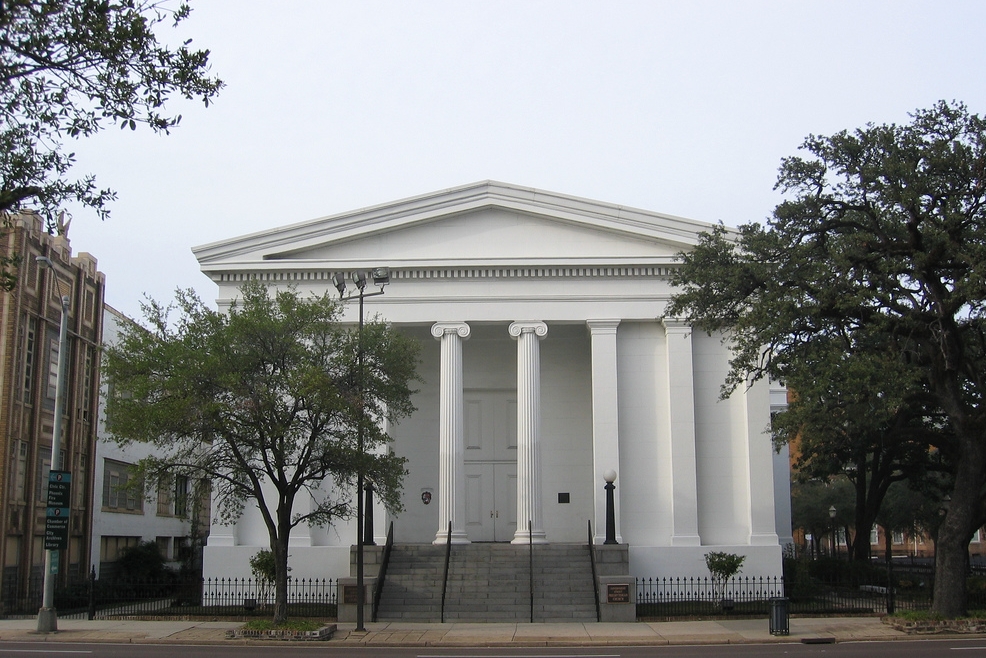- Government Street Presbyterian Church
Infobox_nrhp
name =Government Street Presbyterian Church
nrhp_type =nhl

caption = Government Street Presbyterian Church in 2007.
location= 300 Government StreetMobile, Alabama , USA
lat_degrees = 30
lat_minutes = 41
lat_seconds = 22
lat_direction = N
long_degrees = 88
long_minutes = 2
long_seconds = 37
long_direction = W
locmapin =
area =
built =1836
architect=James Gallier ,James Dakin , and Charles Dakin
architecture= Greek Revival
designated=October 05 ,1992 cite web|url=http://tps.cr.nps.gov/nhl/detail.cfm?ResourceId=2145&ResourceType=Building
title=Government Street Presbyterian Church |accessdate=2007-10-21|work=National Historic Landmark summary listing|publisher=National Park Service]
added =October 05 ,1992 cite web|url=http://www.nr.nps.gov/|title=National Register Information System|date=2007-01-23|work=National Register of Historic Places|publisher=National Park Service]
governing_body = Private
refnum=92001885Government Street Presbyterian Church is one of the oldest and least-altered Greek Revival church buildings in the
United States . The architectural design is byJames Gallier ,James Dakin , and Charles Dakin. The trio also designedBarton Academy , four blocks down Government Street to the west. Government Street Presbyterian reflects the influences ofIthiel Town ,Minard Lafever , andAndrew Jackson Downing . It was declared aNational Historic Landmark in 1992.citation|title=PDFlink| [http://pdfhost.focus.nps.gov/docs/NHLS/Text/92001885.pdf National Historic Landmark Nomination: Government Street Presbyterian Church] |471 KB|date=April 2, 1992 |author=John Sledge and Robert Gamble |publisher=National Park Service and PDFlink| [http://pdfhost.focus.nps.gov/docs/NHLS/Photos/92001885.pdf Accompanying 11 photos, exterior and interior, from 1991.] |2.09 MB]History
The Government Street Presbyterian Church congregation was formally organized in 1831. The congregation purchased the lot at the corner of Government and Jackson Street for $10,000 and local millionaire, Harry Hitchcock, ran an ad in the Mobile Daily Register in December 1835 that advertised for builders. Hitchcock served on the church's building committee and financed much of the construction to come. The drawings and specifications had already been provided by Gallier and Dakin. The construction costs eventually totaled $60,000, with $40,000 of that having gone to the mason, Thomas James.
A hurricane toppled the steeple in 1852, with little damage done to the rest of the structure. Afterwards a committee was formed to determine if it was desirable to rebuild it, and the ladies of the church formed a "steeple society" to raise the funds for the construction. The committee later decided to recommend that the congregation not replace it. A cypress floor was installed over the existing stone one in the basement level in 1869. In 1893 the pulpit was altered and the doors were removed from the pews. In 1898 electrical lighting was introduced, replacing the gas fixtures.
In 1902 a building committee was formed to explore adding more space to the church for a Sunday School. Architects F. Lockwood and Walter Seymour were hired in June 1903 to design an addition. The new addition was finished in 1905 and crossed the back of the existing structure, forming a T-shape. It matched the existing structure in detail and scale. The new construction cost around $12,000. The main sanctuary windows were replaced with stained glass at this time. After another hurricane in 1916 caused $2500 in unspecified damages, and it was decided then to further enlarge the rear portion of the church. This time the architect was C. L. Hutchinson, he added two bays to the north at a cost of $20,000. The main sanctuary was renovated in 1950 with modern lighting and the addition of a glass vestibule just inside the main entrance. The interior was painted and the pews reupholstered in 1976.
Description
The exterior of the building is brick with a stucco finish, intended to have an
ashlar appearance. The bays on the side elevations are divided bypilaster s. The structure is one story over a raised basement with granite foundations and features a gabled roof. The eastern and western edges of the roof were originally adorned withante-fixae . The front gable had an octagonal steeple that came down in a hurricane in 1852 and was never rebuilt. The front elevation features one of the earliest surviving American examples of a distyle portico.Gamble, Robert "Historic architecture in Alabama: a guide to styles and types, 1810-1930", page 58. Tuscaloosa, Alabama: The University of Alabama Press, 1990. ISBN 0817311343.]The interior is notable for the fact that the original Greek Revival design is fully intact with very little alteration. Three entrances lead from the portico into the sanctuary, the southern main doors open directly into the main vestibule, the eastern and western doors both open into side stairway vestibules that access the sanctuary and upper gallery. The sanctuary has two aisles and retains the original pews. The U-shaped gallery is supported by fluted Corinthian columns of a
Tower of the Winds design. The gallery balcony features a Greek key molding topped with rosettes and appears, as does most of the interior, to be based on a design fromMinard Lafever 's "Beauties of Modern Architecture". Behind the altar is a pylon-like screen with an engaged Corinthian tetrasyle topped by ante-fixae, similar in design to theChoragic Monument of Lysicrates . The ceiling iscoffer ed in a diagonal, diamond pattern.Gallery

ee also
*
List of National Historic Landmarks in Alabama References
External links
* [http://tps.cr.nps.gov/nhl/detail.cfm?ResourceId=2145&ResourceType=Building Government Street Presbyterian Church at the National Historic Landmarks Program]
Wikimedia Foundation. 2010.
